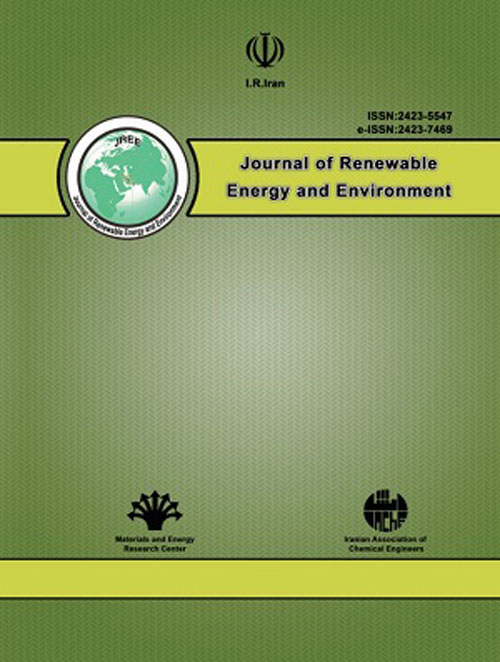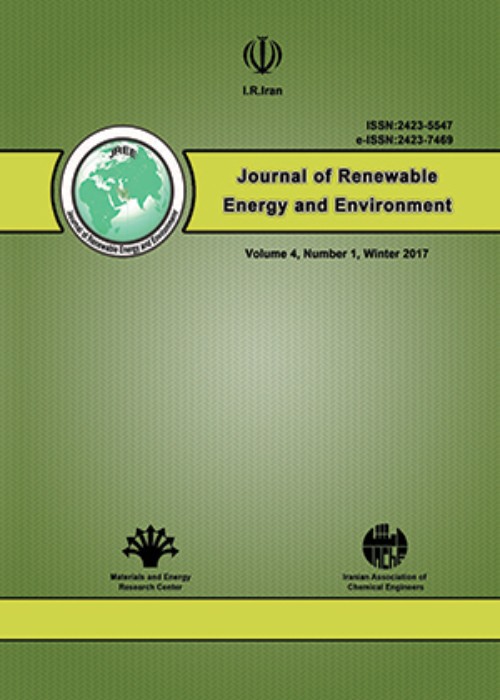فهرست مطالب

Journal of Renewable Energy and Environment
Volume:7 Issue: 3, Summer 2020
- تاریخ انتشار: 1399/05/08
- تعداد عناوین: 7
-
-
Pages 1-13In this paper, the thermal performance of four common insulators in two internal and external insulation systems is investigated for the ASHRAE setpoint range by applying detailed numerical simulation and Anti-Insulation phenomenon. Anti-Insulation phenomenon and consequent extra load on the HVAC system can occur following the thermal insulation of a building if proper temperature setpoint is not selected. In the next step, the proper setpoint is analyzed under simulated building conditions, and all related criteria are studied for this temperature. Also, continuous and intermittent operations of the air conditioning system are investigated. Moreover, the assessment of the environmental benefit of wall insulation is performed by evaluating greenhouse gasses emission payback period and social cost saving. A residential building is simulated in the EnergyPlus software for the case study. Results show that Anti-Insulation occurs approximately at 22 ºC. Both external and internal insulations lead to a significant reduction in energy consumption. Nevertheless, the external insulation shows a bit more reduction. Intermittent operation outperforms the continuous operation by 8 % on average. The insulator’s production phase is considered in the analysis of the insulation environmental benefits. Results show that, in this case, the prioritization of insulators would be different from that case in which this process is not considered. According to results, in terms of social costs, applying thermal insulation to residential buildings is necessary.Keywords: Anti-insulation, Wall insulation configuration, HVAC operation mode, Greenhouse gas emission, Social cost
-
Pages 14-28
Renewable energy provides twenty percent of electricity generation worldwide. Hydroelectric power is the cheapest way to generate electricity today. It is a renewable source of energy and provides almost one-fifth of electricity in the world. Also, it generates electricity using a renewable natural resource and accounting for six percent of worldwide energy supply or about fifteen percent of the world’s electricity. Hydropower is produced in more than 150 countries. Hydropower plant producers provide energy due to moving or falling water. This paper presents and discusses studies on hydroelectric power plant fields, which have been carried out by different investigators. This work aims to study and provide an overview of hydroelectric power plants such as applications, control, operation, modeling and environmental impacts. Also, the hybrid power and efficiency of the hydroelectric power plants has been investigated. The applications of a flexible AC transmission system (FACTS) controller in the power system with the hydroelectric power plants are presented.
Keywords: Control, Reneabel Energy, Hydropower, Hydraulic turbine, Governing system -
Pages 29-47The objective of this study is to evaluate the energy efficiency of residential buildings by using natural energy and optimizing the choice of materials for heat and cold saving with the Ecotect simulation software. According to analysis and simulation was found that the optimum material of main building components in a mild climate zone of Rasht city is the Brick Conc block Plaster for wall with total radiation incident of 340 W/m2 and radiation absorption of 240 W/m2; Double Glazed-Low E for window with total radiation incident 340 W/m2 and radiation absorption of 100 W/m2; Foam Core Ply Wood for door with total radiation incident of 340 W/m2 and radiation absorption of 200 W/m2; ConcSlab- OnGround for floor with total radiation incident of 340 W/m2 and radiation absorption of 220 W/m2; and Conc Roof Asphalt for roof with total radiation incident of 340 W/m2 and radiation absorption of 300 W/m2. According to the hourly temperature analysis for all storeys of the building in the two hot and cold days of the year, it is determined by the design and material selection requirements that the building will be in the near thermal comfort zone (below 30 degrees) in the warm season.Keywords: energy conservation, comparative analysis, Residential Building, Materials, case study
-
Pages 48-55There has been a global effort to reduce the amount of greenhouse gas emissions. In an electric resource scheduling, emission dispatch and load economic dispatch problems should be considered. Using renewable energy resources (RESs), especially wind and solar, can be effective in cutting back emissions associated with power system. Further, the application of electric vehicles (EV) capable of being connected to power grid reduces the pollution level in the transportation sector. This paper investigates a resource scheduling with uncertain behavior of RESs and EVs by considering the penalty factors of emission for each conventional power plant in Hormozgan province of Iran for a 10-year period from 2016 to 2026. In this study, combined-cycle and thermal units are also taken into account. The CPLEX Solver is utilized for resource scheduling problem in GAMS. For combined-cycle power plants, ramp rate constraints are also included. To investigate the impact of uncertainties, different scenarios are considered. The obtained results demonstrate that Hormozgan province has a decent potential of utilizing RESs and EVs to achieve pollution reduction and optimal cost.Keywords: Scheduling of Power plants, Plug-in Hybrid Electric Vehicles, GAMS, uncertain behavior
-
Pages 56-66In this research, an analytical method for quantification of the thermal energy performance improvement for a building integrated photovoltaic double-skin façade has provided. The system has been suggested as a retrofit measure for an existing building in Tehran. The effect of thermal performance has been analyzed through computer-assisted developed code using engineering equation solver software. Three scenarios have been defined and for each scenario temperature and velocity profiles have provided through continuity, momentum and energy equations. As the monocrystalline photovoltaic modules and the double-glazed windows are more conventional in the current condition in Tehran, the authors have considered them for the analysis. A comparison of results for this study is valuable for the cases intending to select between the glass and the photovoltaic as the outer façade. The quantitative results illustrate that the proposed system would be able to reduce the cooling demand in the summer case by 18.5 kilowatts, which is around 8.7 percent of the current cooling load. According to the results of the sensitivity analysis, both glass and photovoltaic façades have a greater impact in terms of energy saving in the summer case. According to the results of the analysis, by increasing the ratio between the photovoltaic outer façade to the surface area of the glass section, the amount of the energy saving due to the total cooling load reduction will increase. The results of the analysis showed that the application of the suggested system will reduce the thermal load by 2.1 percent in the winter season.Keywords: analytical method, Building Integrated Photovoltaic Thermal, Double skin façade, Energy Saving, Thermal Performance
-
Pages 67-79
As a key economic element, energy plays an important role in the development of societies. Economic growth and its urgent need for energy highlight the need for optimal energy use. Wind energy is an energy source that has become an increasingly common source of electricity. In this study, socio-economic impacts of the cost of electricity generated by wind power plants were assessed with Iran as the focus of this study. The environmental impacts of wind energy were also considered by reviewing and analyzing research papers. Studies showed that although the use of wind energy in Iran began in Manjil in northern Iran, no significant progress has been made in this field despite all the efforts over the past years. The results indicated that the initial cost of launching wind turbines was the most important factor in the failure of this technology. The costs of purchasing turbines, construction of roads, provision of electrical infrastructure, project management, installation of turbines, insurance premiums, grid connections, and power lines were shown to affect costs of energy production. Furthermore, operation and maintenance costs, the choice of installation location, increasing production capacity, expansion of the energy market, and policies in the country can play an essential role in determining the cost of wind energy production. Given that power generation using wind turbines are economical, it is recommended that turbines be installed in suitable windy locations. In addition, considering that one of the crises facing the world and especially Iran is environmental pollution, utilizing energies such as wind energy for generating electricity is advised due to their lower pollutant emissions and lower economic and social costs.
Keywords: Renewable Energy, Environmental pollution, Wind power plant, Global warming, Iran -
Pages 70-76
Renewable energies as a clean replacement resource of fossil fuels have many advantages, among which wind has the potential to be the very applicable source in the world. To use wind energy, two kinds of turbines have been developed; the Vertical Axis Wind Turbine (VAWT) and Horizontal Axis Wind Turbine (HAWT). In small scale applications, using a VAWT has some advantages such as low cost and noise, simple mechanism, and the low sensitivity to the wind direction. In this paper, the design and analysis of a combined wind turbine, consist of the Savonius-Darrieus rotor, are performed to use in irrigation applications. To predict the output power, a series of experiments were conducted using the Computational Fluid Dynamics (CFD) method. For this purpose, ANSYS fluent and Q-Blade software programs are used. To design the rotor performance, NACA symmetric airfoils are considered. Next, this combined turbine was made and experimental tests were performed. Finally, the output power is computed and so, the water flow rate for irrigation purposes such as water pumping is obtained. The results indicate that the self-starting of the turbine is improved using the considered design. This could be useful in regions with low wind speed.
Keywords: Irrigation, Combined Savonius-Darrieus Wind Turbine, Experimental Setup, CFD, ANSYS, Q-Blade


